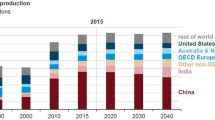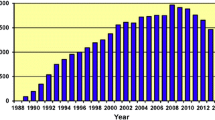Abstract
The shale gas revolution occurring in the United States at the beginning of the twenty-first century has fueled worldwide interest in unconventional natural gas. The existence of gas trapped in tight pore spaces has been known for decades, but only the recent possibility of implementing advanced production methods and favorable market conditions have made its exploitation economically feasible. The extraction of unconventional gas is already a reality in many countries, but in others, such as France, where the existence of shale gas and coal seam gas has been proven, there are no plans to employ this energy resource in the short term. In such geographical contexts, it has become pressing to understand what role unconventional gas could play in the energy transition. The chapter draws on peer-reviewed articles and statistics to reflect on the contribution of gas in meeting European energy demand. The current French position does not seem to view gas exploitation in a favorable light, let alone unconventional gas. Such a position is questionable, given that France must import all of the gas it uses and, to decrease its dependence on nuclear, it would need to use more gas to generate electricity.
Similar content being viewed by others
Notes
- 1.
For the sake of completeness, the power density (Pd) is calculated by taking the quotient between the quantity of energy (E) produced by an energy converter (thermal, hydroelectric, wind power plant, photovoltaic panel, etc.) and the areas (S) necessary for the operation of the energy system: Pd(W/m2) = E(Wh)/S (m2).
Abbreviations
- CCGT:
-
Combined Cycle Gas Turbine
- COP21:
-
21st Conference of the Parties
- CSG:
-
Coal Seam Gas
- DEHP:
-
Department of Environment and Heritage Protection
- EIA:
-
Energy Information Administration
- EUOGA:
-
European Unconventional Oil and Gas Assessment
- FDE:
-
Française de l’Energie (company)
- GT:
-
Gas turbine
- PPE:
-
Programmation Pluriannuelle de l’Energie (Multi-annual Energy Plan)
- SRADDET:
-
Schémas régionaux d’aménagement, de développement durable et d’égalité des territoires (Regional Planning, Sustainable Development and Territorial Equality Plans)
- ST:
-
Steam turbine
References
Azubuike, S.I., et al. (2018) ‘Identifying policy and legal issues for shale gas development in Algeria: A SWOT analysis’, The Extractive Industries and Society, 5(4), pp. 469−480. https://doi.org/10.1016/j.exis.2018.10.005.
Bădileanu, M., et al. (2015) ‘Shale Gas Exploitation – Economic Effects and Risks’, Procedia Economics and Finance, 22, pp. 95−104. https://doi.org/10.1016/S2212-5671(15)00231-2.
Barth, J.M. (2013) ‘The economic impact of shale gas development on state and local economies: benefits, costs, and uncertainties’, NEW SOLUTIONS: A Journal of Environmental and Occupational Health Policy, 23(1), pp. 85−101. https://doi.org/10.2190/NS.23.1.f.
Beauloye, Y., Deshaies, M., Gunzburger, Y. (2021) ‘Conditions for the territorial anchorage of a natural gas exploitation project’, The Extractive Industries and Society, 8(1), pp. 74−82. https://doi.org/10.1016/j.exis.2020.04.005.
Bec, A., Moyle, B.D., McLennan, C.-I. (2016) ‘Drilling into community perceptions of coal seam gas in Roma, Australia’, The Extractive Industries and Society, 3, pp. 716−726. https://doi.org/10.1016/j.exis.2015.12.007.
Black K., et al. (2021) ‘Economic, Environmental, and Health Impacts of the Fracking Boom’, Annual Review of Resource Economics, 13. https://doi.org/10.1146/annurev-resource-110320-092648.
BP, Statistical Review of World Energy 2020, Available at: https://www.bp.com/content/dam/bp/business-sites/en/global/corporate/pdfs/energy-economics/statistical-review/bp-stats-review-2020-full-report.pdf (Accessed 30 December 2021)
Buse, C.G., et al. (2019) ‘Locating community impacts of unconventional natural gas across the supply chain: A scoping review’, The Extractive Industries and Society, 6(2), pp. 620–629. https://doi.org/10.1016/j.exis.2019.03.002.
Chailleux, S. (2017) ‘Les leçons de la controverse du gaz de schiste en France et au Québec’, in Gunzburger Y., Le gaz de charbon en Lorraine. Quelle intégration dans le territoire?’, CNRS éditions, pp. 185–196.
Chen, C., Randall, A. (2013) ‘The Economic Contest between Coal Seam Gas Mining and Agriculture on Prime Farmland: It May Be closer than We Thought’, Journal of Economic and Social Policy, 15(3), pp. 87–118. https://doi.org/10.3316/ielapa.794885109424026.
Costa D., et al. (2017) ‘Extensive review of shale gas environmental impacts from scientific literature (2010-2015)’, Environmental Science and Pollution Research, 24, 14579−14594. https://doi.org/10.1007/s11356-017-8970-0.
Cooper, J., Stamford, L., Azapagic, A. (2016) ‘Shale Gas: A Review of the Economic, Environmental, and Social Sustainability’, Energy Technology, 4(7), pp. 772–792. https://doi.org/10.1002/ente.201500464.
Daviet, S. (2005) ‘Trente ans de géographie industrielle dans les Annales de géographie (1970-1999)’, Annales de géographie, 641(1), pp. 73–92.
Department of Environment and Heritage Protection, Queensland Government (2012) Coal Seam Gas Water Management Policy. Available at: https://environment.des.qld.gov.au/__data/assets/pdf_file/0034/89386/rs-po-csg-water-management-policy.pdf (Accessed 28 December 2021).
Deshaies, M. (2014) ‘Ambiguïtés et limites de la transition énergétique en Allemagne’, VertigO - la revue électronique en sciences de l’environnement, 14(3). https://doi.org/10.4000/vertigo.15515.
Deshaies, M. (2021) ‘Pacte vert et enjeux énergétiques dans l’UE: l’étrange ambiguïté de la politique énergétique allemande’, Allemagne d’aujourd’hui, 2021/2(236), pp. 43–57.
de Rijke, K. (2018) ‘Produced water, money water, living water: Anthropological perspectives on water and fracking’, Wiley Interdisciplinary Reviews: Water, 5(2), e1272. https://doi.org/10.1002/wat2.1272.
Energy Information Administration (2011) World Shale Gas Resources: An Initial Assessment of 14 Regions Outside the United States. Available at: https://www.eia.gov/analysis/studies/worldshalegas/archive/2011/pdf/fullreport.pdf (Accessed 20 June 2022)
Energy Information Administration (2013) Technically Recoverable Shale Oil and Shale Gas Resources: An Assessment of 137 Shale Formations in 41 Countries Outside the United States. Available at: https://www.eia.gov/analysis/studies/worldshalegas/pdf/overview.pdf (Accessed 20 June 2022)
European Unconventional Oil and Gas Assessment (2017) European Unconventional Oil and Gas Assessment: Resource Estimation of shale gas and shale oil in Europe. Available at: https://joint-research-centre.ec.europa.eu/system/files/2017-09/t7_appendix.pdf (Accessed 20 June 2022)
Ferguson M.D., et al. (2020) ‘What do outdoor recreationists think of fracking? Politics, ideology, and perceptions of shale gas energy development in Pennsylvania State Forests’, Energy Research & Social Science, 62, 101384. https://doi.org/10.1016/j.erss.2019.101384.
Furfari, S. (2020) L’utopie hydrogène, Independly published.
Grand, D., Le Brun, C., Vidil, R. (2014) ‘Transition énergétique et mix électrique: les énergies renouvelables peuvent-elles compenser une réduction du nucléaire?’, La Revue de l’énergie, 619, mai-juin, pp. 211–220.
Hennig, F. (2021) Klimadämmerung. Vom Ausstieg zur Abstieg-Ein Plädoyer für mehr Vernunft in der Energiepolitik, Finanzbuchverlag, München.
Hu, D., Xu, S. (2013) ‘Opportunity, challenges and policy choices for China on the development of shale gas’, Energy Policy, 60, 21–26. https://doi.org/10.1016/j.enpol.2013.04.068.
Huth N.I., et al. (2018) ‘Farmers’ perceptions of coexistence between agriculture and a large scale coal seam gas development’, Agriculture and Human Values, 35(1), pp. 99–115. https://doi.org/10.1007/s10460-017-9801-0.
Janda, K., Kondratenko, I. (2018) An Overview of Economic Impacts of Shale Gas on EU Energy Security. MPRA Paper No. 83945. Available at: https://mpra.ub.uni-muenchen.de/83945/1/MPRA_paper_83945.pdf (Accessed 20 June 2022)
Kavalov, B., Pelletier, N. (2012) Shale Gas for Europe – Main Environmental and Social Considerations: A Literature Review. European Union, Luxembourg: Publications Office of the European Union. https://doi.org/10.2788/48370.
Kinnaman, T.C. (2011) ‘The economic impact of shale gas extraction: A review of existing studies’, Ecological Economics. 70(7), pp. 1243–1249. https://doi.org/10.1016/j.ecolecon.2011.02.005.
Krupnick A., Wang Z., Wang Y. (2014) ‘Environmental risks of shale gas development in China’, Energy Policy, 75, pp. 117−125. https://doi.org/10.1016/j.enpol.2014.07.022.
Lachapelle, E., Kiss, S., Montpetit, É. (2018) ‘Public perceptions of hydraulic fracturing (Fracking) in Canada: Economic nationalism, issue familiarity, and cultural bias’, The Extractive Industries and Society, 5(4), pp. 634−647. https://doi.org/10.1016/j.exis.2018.07.003.
Ladd, A.E. (2013) ‘Stakeholder Perceptions of Socioenvironmental Impacts from Unconventional Natural Gas Development and Hydraulic Fracturing in the Haynesville Shale’, Journal of Rural Social Sciences, 28(2), pp. 56−89.
Larkin, P., et al. (2018) ‘Ensuring health and environmental protection in hydraulic fracturing: A Focus on British Columbia and Alberta, Canada’, The Extractive Industries and Society, 5(4), pp. 581−595. https://doi.org/10.1016/j.exis.2018.07.006.
Le, M.-T. (2018) ‘An assessment of the potential for the development of the shale gas industry in countries outside of North America’, Heliyon, 4(2), e00516. https://doi.org/10.1016/j.heliyon.2018.e00516.
Li, G., Luo, K., Shi, D. (2020) ‘Key technologies, engineering management and important suggestions of shale oil/gas development: Case study of a Duvernay shale project in Western Canada Sedimentary Basin’, Petroleum Exploration and Development, 47(4), pp. 791–820. https://doi.org/10.1016/S1876-3804(20)60094-5.
Mactaggart, F., et al. (2018) ‘Exploring the determinants of health and wellbeing in communities living in proximity to coal seam gas developments in regional Queensland’, PMC Public Health, 18(1), 51. https://doi.org/10.1186/s12889-017-4568-1.
Mason, C.F., Muehlenbachs, L.A., Olmstead, S.M. (2015) ‘The Economics of Shale Gas Development’, The Annual Review of Resource Economics, 7, pp. 269–289. https://doi.org/10.1146/annurev-resource-100814-125023.
McCrea, R., Walton, A., Leonard, R. (2019) ‘Rural communities and unconventional gas development: What’s important for maintaining subjective community wellbeing and resilience over time’, Journal of Rural Studies, 68, pp. 87–99. https://doi.org/10.1016/j.jrurstud.2019.01.012.
Measham, T.G., Fleming, D.A., Schandl, H. (2016) ‘A conceptual model of the socioeconomic impacts of unconventional fossil fuel extraction’, Global Environmental Change, 36, pp. 101−110. https://doi.org/10.1016/j.gloenvcha.2015.12.002.
Mehreen, S.U., Underschultz, J.R. (2016) ‘Coexistence Opportunities for Coal Seam Gas and Agribusiness’, Journal of Industrial Ecology, 21(5), pp. 1344−1355. https://doi.org/10.1111/jiec.12521.
Monckton, D., et al. (2017) ‘Use of coal seam water for agriculture in Queensland, Australia’, Water International, 42(5), pp. 599–617. https://doi.org/10.1080/02508060.2017.1339259.
Oxford Institute for Energy Studies (2018) Norwegian Gas Exports – Assessment of Resources and Supply to 2035, The Oxford Institute For Energy Studies. Available at https://www.oxfordenergy.org/wpcms/wp-content/uploads/2018/03/Norwegian-Gas-Exports-Assessment-of-Resources-and-Supply-to-2035-NG-127.pdf (Accessed 28 December 2021).
O’Connor, C., Fredericks, K. (2018) ‘Citizen perceptions of fracking: The risks and opportunities of natural gas development in Canada’, Energy Research & Social Science, 42, 61−69. https://doi.org/10.1016/j.erss.2018.03.005.
Rahm, D., Fields, B., Farmer, J.L. (2015) ‘Transportation impacts of fracking in the Eagle Ford Shale Development in rural south Texas: Perceptions in the Eagle Ford Shale Development in rural south Texas: Perceptions of local government officials’, The Journal of Rural and Community Development, 10(2), pp. 78−99.
Rivard, C., et al. (2014) ‘An overview of Canadian shale gas production and environmental concerns’, International Journal of Coal Geology, 126, pp. 64−76. https://doi.org/10.1016/j.coal.2013.12.004.
Rogner, H.-H. (1997) ‘An Assessment of World Hydrocarbon Resources’, Annual Review of Environmental and Resources, 22, pp. 217−262. https://doi.org/10.1146/annurev.energy.22.1.217.
Smil, V. (2015a). Power Density, The MIT Press, Cambridge, Massachusetts.
Smil, V. (2015b) Natural Gas, Fuel for the 21st Century, Chichester, UK: Wiley.
Smil, V. (2017) Energy Transitions: Global and National Perspectives, 2nd edition, Santa Barbara, California. Denver, Colorado: Praeger.
Tan, H., Xu, J., Wong-Parodi. G. (2019) ‘The politics of Asian fracking: Public risk perceptions towards shale gas development in China’, Energy Research & Social Science, 54, pp. 46−55. https://doi.org/10.1016/j.erss.2019.03.007.
Tan, H., Wong-Parodi, G., Xu, J. (2020) ‘Not under my backyard? Psychological distance, local acceptance, and shale gas development in China’, Energy Research & Social Science, 61, 101336. https://doi.org/10.1016/j.erss.2019.101336.
Theodori, G.L. (2009) ‘Paradoxical perceptions of problems associated with unconventional natural gas development’, Southern Rural Sociology, 24(3), pp. 97–117.
Thomas, M., et al. (2017) ‘Public perceptions of hydraulic fracturing for shale gas and oil in the United States and Canada’, WIREs Clim Change, 8(3), e450. https://doi.org/10.1002/wcc.450.
Truong, D., Davidson, D.J., Parkins, J.R. (2019) ‘Context matters: Fracking attitudes, knowledge and trust in three communities in Alberta, Canada’, The Extractive Industries and Society, 6(4), pp. 1325−1332. https://doi.org/10.1016/j.exis.2019.09.004.
Turton, D.J. (2019) ‘Fracturing planners: A study of their contribution to Australia’s coal seam gas debate’, The Extractive Industries and Society, 6(4), pp. 1314−1324. https://doi.org/10.1016/j.exis.2019.11.007.
Walton, A.M., et al. (2013) ‘Resilience in a Changing Community Landscape of Coal Seam Gas: Chinchilla in Southern Queensland’, Journal of Economic and Social Policy, 15(3). Available at http://epubs.scu.edu.au/jesp/vol15/iss3/2.
Witt, K., et al. (2018) ‘Industry and government responses to unconventional gas development in Australia’, The Extractive Industries and Society, 5(4), pp. 422−426. https://doi.org/10.1016/j.exis.2018.09.012.
Zwickl, K. (2019) ‘The demographics of fracking: A spatial analysis for four U.S. states’, Ecological Economics, 161, pp. 202−215. https://doi.org/10.1016/j.ecolecon.2019.02.001.
Akowledgement
This study was supported by Université de Lorraine (REGALOR project).
Author information
Authors and Affiliations
Corresponding author
Editor information
Editors and Affiliations
Section Editor information
Rights and permissions
Copyright information
© 2022 The Author(s), under exclusive licence to Springer Nature Switzerland AG
About this entry
Cite this entry
Deshaies, M., Bressan, G. (2022). Relying on Unconventional Gas Development Projects for the Energy Transition: A Review of Recent Energy History and the Contested Role of Unconventional Gas in France. In: Wood, G., Onyango, V., Yenneti, K., Liakopoulou, M.A. (eds) The Palgrave Handbook of Zero Carbon Energy Systems and Energy Transitions. Palgrave Studies in Energy Transitions. Palgrave Macmillan, Cham. https://doi.org/10.1007/978-3-030-74380-2_36-1
Download citation
DOI: https://doi.org/10.1007/978-3-030-74380-2_36-1
Received:
Accepted:
Published:
Publisher Name: Palgrave Macmillan, Cham
Print ISBN: 978-3-030-74380-2
Online ISBN: 978-3-030-74380-2
eBook Packages: Springer Reference Social SciencesReference Module Humanities and Social SciencesReference Module Business, Economics and Social Sciences




